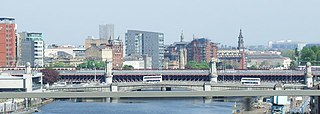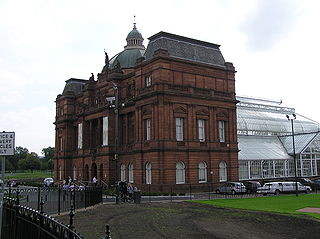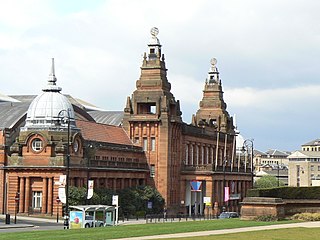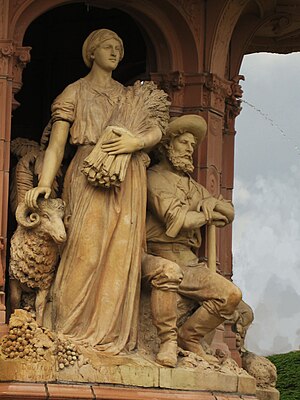
Glasgow is the most populous city in Scotland and the fourth-most populous city in the United Kingdom, as well as being the 27th largest city by population in Europe. In 2020, it had an estimated population of 635,640. Straddling the border between historic Lanarkshire and Renfrewshire, the city now forms the Glasgow City Council area, one of the 32 council areas of Scotland, and is governed by Glasgow City Council. It is situated on the River Clyde in the country's West Central Lowlands.

Kelvingrove Art Gallery and Museum is a museum and art gallery in Glasgow, Scotland. It reopened in 2006 after a three-year refurbishment and since then has been one of Scotland's most popular visitor attractions. The museum has 22 galleries, housing a range of exhibits, including Renaissance art, taxidermy, and artifacts from ancient Egypt.

Kelvingrove Park is a public park located on the River Kelvin in the West End of the city of Glasgow, Scotland, containing the Kelvingrove Art Gallery and Museum.

Glasgow Green is a park in the east end of Glasgow, Scotland, on the north bank of the River Clyde. Established in the 15th century, it is the oldest park in the city.

The People's Palace and Winter Gardens in Glasgow, Scotland, is a museum and glasshouse situated in Glasgow Green, and was opened on 22 January 1898 by The 5th Earl of Rosebery.
The city of Glasgow, Scotland, has many amenities for a wide range of cultural activities, from curling to opera and from football to art appreciation; it also has a large selection of museums that include those devoted to transport, religion, and modern art. In 2009 Glasgow was awarded the title UNESCO Creative City of Music in recognition of its vibrant live music scene and its distinguished heritage. Glasgow has three major universities, each involved in creative and literary arts, and the city has the largest public reference library in Europe in the form of the Mitchell Library. Scotland's largest newspapers and national television and radio companies are based in the city.

Whiteinch is an area in the city of Glasgow, Scotland. It is situated directly north of the River Clyde, between the Partick and Scotstoun areas of the city. Whiteinch was at one stage part of the burgh of Partick, until that burgh's absorption into the expanding city of Glasgow in 1912, and part of the Parish of Govan.

The Kelvin Hall, located on Argyle Street in Glasgow, Scotland, is one of the largest exhibition centres in Britain and now a mixed-use arts and sports venue that opened as an exhibition venue in 1927. It has also been used as a concert hall, home to the Kelvin Hall International Sports Arena to 2014, and from 1988 to 2010, Glasgow's Museum of Transport. As part of the economic redevelopment of Greater Glasgow promoted by the Scottish Development Agency and local authorities to enhance the city's tourist infrastructure and to attract further national and international conferences, the Scottish Exhibition and Conference Centre was designed as the Hall's successor for exhibitions and entertainments, built and opened on the nearby Queen's Dock in 1985 with an exhibition area equal in size to the Kelvin Hall but with the benefit of extensive car parks and land for other complementary buildings. The Hall is protected as a category B listed building, and is served by city bus services and by Kelvinhall subway station.
The Glasgow Museum of Transport in Glasgow, Scotland was established in 1964 and initially located at a former tram depot in Pollokshields. In 1988 the museum was relocated to the city's Kelvin Hall, then moved to its current location in the Riverside Museum building at Glasgow Harbour in 2011.

The Kelvin Hall International Sports Arena was located within the Kelvin Hall in Glasgow, Scotland. It hosted many athletics competitions including the 1990 European Athletics Indoor Championships and the Glasgow International Match from 1988 until 2012 when it moved to the Commonwealth Arena.

The Glasgow Garden Festival was the third of the five national garden festivals, and the only one to take place in Scotland.

Empire Exhibition, Scotland 1938 was an international exposition held at Bellahouston Park in Glasgow, from May to December 1938.

James Sellars was a Scottish architect who was heavily influenced by the work of Alexander Greek Thomson.

The Glasgow International Exhibition was the second of 4 international exhibitions held in Glasgow, Scotland during the late 19th and early 20th centuries. The exhibition took place during a period of half-mourning requested by Edward VII but was still popular and made more than £35000 profit. The exhibition was opened by the King's daughter, the Princess Louise, Duchess of Fife.

The Scottish Exhibition of National History, Art and Industry was held in Glasgow in 1911. It was the third of 4 international exhibitions held in Glasgow, Scotland during the late 19th and early 20th centuries.
Events from the year 1888 in Scotland.

The Kelvingrove Lawn Bowls and Tennis Centre is a sports complex located in Glasgow, Scotland. Located on Kelvin Way off Sauchiehall Street and adjacent to the Kelvingrove Art Gallery and Museum, Kelvingrove Park and the Yorkhill and Kelvingrove residential neighbourhoods, it is owned by Glasgow City Council and was a venue for the 2014 Commonwealth Games and has been used for the purpose since at least 1910. In addition to a number of lawn bowls greens, the facility has six artificial grass tennis courts which are available to the public to play for free.
The Exhibition Cup was a one-off football tournament contested in Glasgow, Scotland. Held to coincide with the International Exhibition of Science, Art and Industry, this early season competition was won by Cowlairs, beating Celtic in the final. The matches, played over the month of August 1888 with the final on 6 September, were staged at the University of Glasgow recreation grounds at Gilmorehill, close to the exhibition's main site at Kelvingrove. While the tournament winners were awarded a handsome trophy, the runners up were presented with gold badges.


![The Doulton Fountain [de] Doulton Fountain - Glasgow Green.jpg](http://upload.wikimedia.org/wikipedia/commons/thumb/b/ba/Doulton_Fountain_-_Glasgow_Green.jpg/300px-Doulton_Fountain_-_Glasgow_Green.jpg)














